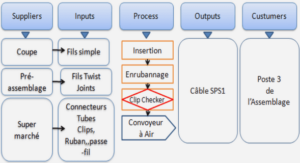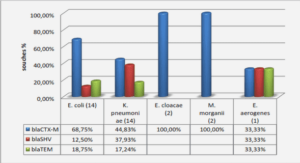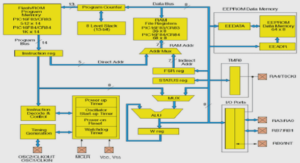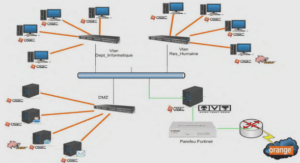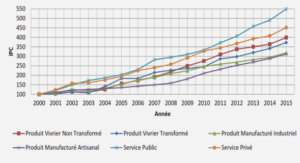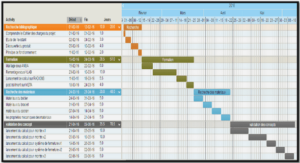BONE MARROW-DERIVED MICROGLIA PLAYS A CRITICAL ROLE IN NEUROPATHIC PAIN
Macrophage and microglia
Macrophages are cells within tissues that originate from monocytes. Macrophages are versatile cells that play many roles. As scavengers, they rid the body of worn-out cells and other debris. After digesting a pathogen, macrophages will present antigens of the pathogen to T cells, a crucial event in the initiation of immune responses. As secretory cells, monocytes and macrophages are vital to the regulation of immune responses and the development of inflammation; they produce
an amazing array of powerful chemical substances including enzymes, complement proteins, and regulatory factors such as interleukin (IL)-1. Immediately after nerve injury, resident macrophages and monocytes from the peripheral blood rush to the lesion site and massively infiltrate damaged nerves and the DRGs on the ipsilateral side, eventually surrounding cell bodies from injured sensory neurons. The immune response in the periphery is driven by invasion of immune cells and orchestrated with local satellite and Schwann’s cells through cytokines/chemokines network (Scholz and Woolf, 2007). Pro-inflammatory cytokines, including IL-lp, TNF-a, and IL-6 can directly modulate neuronal activity and elicit spontaneous action potential discharges (Wolf et al., 2006).
Microglia are considered as being the resident macrophages of the brain and spinal cord. They make up 5-15% ofthe total glial population in the CNS. They become activated at early stage in response to injury, infections, ischemia, brain tumors and neurodegeneration. Activated microglia are characterized by a specific morphology, proliferation, increased expression of cell surface markers or receptors and changes in functional activities, such as migration to areas of damage, phagocytosis, and production/release of pro-inflammatory substances (Gehrmann et al., 1995). There are many different microglial activation states, with various components expressed with different time-courses and intensities that are dependent on the stimulus that triggers activation. Functional and morphological changes are not time-locked, one can be detected in the absence ofthe other (Raivich et al., 1999).Different from other glial cells, microglia originate from monocytic mesodermal cells and also derive from the infiltration of hematopoietic cells during the early development of the CNS. The normal CNS is characterized by two major monocyte-related populations: highly ramified, resting microglia inside the CNS parenchyma and perivascular macrophages on the luminal side of brain vessel-associated basal membranes. During development and shortly after birth, monocyte precursor cells populate the brain and thereby give rise to microglia. The renewal of microglia in the adult CNS is traditionally thought to occur exclusively via proliferation of resident differentiated cells. However, recent evidence suggests that, under certain circumstances, microglia can also come from a second population (macrophages). These macrophages are elongated and located around blood vessels. Perivascular macrophages are gradually replenished by circulating monocytes. Thus, severe inflammation could lead monocytes to infiltrate the brain through the blood-brain barrier. Many ofthe hematognous monocytes invading CNS parenchyma will later ramify and gradually transform into microglia-like cells. Inflammatory stimuli may also lead to rapid activation of resident microglia, which may transform into phagocytic macrophages in the presence of cellular debris. Thus, both populations of macrophages oftmacrophages-resident microglia and hematogenous macrophages-monocytes) may contribute to the removal of debris.
Microglia act as the first and main form of active immune defense in the CNS. Microglia are distributed throughout the brain and spinal cord and are constantly moving and analyzing the CNS for damaged neurons, plaques, and infectious agents(Nimmerjahn, science,2005). The brain and spinal cord are considered « immune privileged » organs in the sense that they are separated from the rest of the body by a series of endothelial cells, interconnected by complex tight junction, known as the blood-brain barrier (BBB) and blood-spinal cord barrier(BSB), respectively. One of the roles of the BBB/BSB is to prevent most infections microbes from reaching the vulnerable nervous tissue. In the case in which infectious agents are directly introduced into the CNS, microglia must react quickly by initiating inflammation and destroying infectious agents before they cause damage to neural tissue. Microglias are extremely sensitive to even small pathological changes occurring in the CNS. Microglia activation could be neuroprotective or neurotoxic, which depends partially on the microenvironment.
Activated Microglia and Neuropathic Pain
Until very recently, chronic pain, such as neuropathic pain, was thought to be mediated only through the dysfunction of neurons. However, recent studies have shown that neuroimmune alterations may also contribute to pain after injury to the nervous system. The fact that peripheral nerve injury can induce spinal microglial/astrocytic activation has been demonstrated in several chronic neuropathic pain models (Colburn et al., 1999; Zhang et al ., 2003; Fu et al., 1999). Activated microglia release pain-enhancing substances such as pro-inflammatory cytokines, nitric oxide (NO), prostaglandins (PGs), and excitatory amino acids (EAA) (Hashizume et al., 2000), that excite spinal pain responsive neurons either directly or indirectly, and promote the release of other transmitters that can act on nociceptive neurons (Watkins et al., 2003). Several drugs that disrupt glia signaling by targeting glial activation (Milligan et al., 2003; Raghavendra et al., 2003), inhibiting the synthesis of cytokines, blocking pro-inflammatory cytokine receptors (Sweitzer et al., 2001), or disrupting pro-inflammatory cytokine signaling pathway (Sweitzer et al., 2004) have successfully controlled enhanced nociceptive states in animal models. All these data strongly suggest that spinal cord glia are important pain modulators.
At the junction between incoming central neurons from DRG sensory reunions and cell bodies from secondary ascending neurons, microglia patrol the spinal cord environment and are ready to intervene if necessary, like following an injury.
Nerve injury induced-stereotypic microglial activation is characterized by a striking increase of Iba-1 ir on the ipsilateral side DH and VH. Iba-1 (ionized binding adaptor protein-1) is a marker specific for microglia (Fig. 1.2). On the contralateral side, the resting microglia have long, ramified processes, and they are well spaced from one another. On the ipsilateral side, the affected microglia show an increase in the size of the cell body, a thickening of proximal processes and a decrease in the ramification of distal branches; they appear to be more densely packed together. Temporally, microglia respond to nerve injury very early. The increase of OX-42 ir (another marker for microglia) started both in VH and DH at day 3 post-injury, increased significantly at day 7, then peaked at day 14, a time at which activated microglia were condensed around sensory nerve terminals in the dorsal horn and around motoneuron cell bodies in the ventral horn. From day 22, the intensity of OX-42-ir declined. On day 150, intensity of OX-42ir was similar to that on the contralateral side, although some activated microglia were also present on the contralateral side (Zhang and DeKoninck, 2006). Microglial activation is a graded process of acquisition of many functions: not only the morphological transformation from ramified to rod like or ameboid shape, Microglial activation also results in temporal changes in gene expression. The acquired functions could include cell proliferation, migration, phagocytosis, regulation of antigen-presenting cell capabilities, up-regulation of cell surface receptors, and secretion of pro-inflammatory mediators: cytokines, chemokines, PGE2, secretion of anti-inflammatory cytokines.
MCP-1/CCR2
Chemokines are a family of small proteins (8-10 kDa), initially recognized as chemoattractant cytokines controlling immune cell trafficking, a process important in host immune surveillance. According to the number and spacing of the conserved N-terminal cysteines, chemokines are classified into four classes (C, CC, CXC, CX3C) and act through specific or shared receptors that all belong to the superfamily of G-protein-coupled receptors (GPCR). Chemokines are extracellular signaling proteins that produce endocrine, paracrine and autocrine effects. In contrast to circulating endocrine hormones, they can exert their effects on nearby cells over short extracellular distances at low concentration. It is well established that chemokines play an important role in the pathogenesis of neuroinflammatory disease states, such as multiple sclerosis (Bajetto et al., 2001).
Monocyte chemoattractant protein-1 (MCP-1) is a member ofthe CC chemokine family that specifically attracts and activates monocytes to sites of inflammation (Leonard et al., 1991). Recent studies have suggested a role for MCP-1 and its receptor CÇR2 in nociception. Both intraplantar and intrathecal injections of this chemokine have been shown to induce mechanical allodynia (Tanaka et al., 2004). Mutant mice lacking the MCP-1 receptor CCR2 (CCR2″A) do not develop tactile allodynia after nerve injury (Abbadie et al., 2003). Expressed normally by peripheral immune cells, MCP-1 can be induced in neurons by nerve injury (Flugel et al., 2001; Schreiber et al., 2001; Zhang and De Kononck, 2006). Following sciatic nerve injury, MCP-1 mRNA and protein expression has been identified on DRG sensory neurons on the side ipsilateral to the nerve injury. The induction of MCP-1 in damaged neurons started as early as day 1 post-injury, peaked around 1-2 weeks and then reduced progressively afterwards. In addition, induced MCP-1 protein in DRG was transported to the ipsilateral spinal cord dorsal horn (Zhang and De Koninck, 2006). CCR2, the receptor for MCP-1 is expressed selectively on cells of monocyte/macrophage lineage in the periphery (Rebenko-Moll et al., 2006) and can be induced in spinal microglia by peripheral nerve injury (Abbadie et al., 2003). It has also been demonstrated that both spatially and temporally, MCP-1 induction is closely correlated with the subsequent surrounding microglial activation (Zhang and De Koninck, 2006). All these data strongly suggest that the induced neuronal MCP-1 could be the signaling molecule that activates resident microglial activation and and/or attracts peripheral macrophages into the spinal cord, and consequently contributes to the development of mechanical allodynia
Research problem
The mechanisms underlying neuropathic pain after peripheral nerve injury are still under investigation, especially the involvement of glial cells in the pathogenesis. Neuropathic pain is generally chronic, severe, and resistant to treatment with counter analgesics. The advanced research activities could unravel new targets for an effective treatment. During my graduate studies, I tried to answer the following
questions:
/. What are the origins of these activated microglia?
Are they only CNS resident microglia or do they also include some newly generated microglia?
Are they only CNS resident microglia or do some of them are derived from infiltrating monocytes?
What triggers quiescent spinal cord glia to become activated in response to nerve damage?
Animal model and behavioral testing
Why we chose the partial sciatic nerve ligation (PSNL) model
The PSNL model (Seltzer et al., 1990+) is widely used in the study of neuropathic pain. Perhaps even more importantly, partial nerve injury is the main cause of causalgiform pain disorders in humans. Thus, this model could similarly mimic injuries observed in patients suffering from neuropathic pain.
How to make PSNL and the main characteristics ofthe model
In mice, like in rats, we unilaterally ligated about half of the sciatic nerve high in the thigh. Within a few hours after the operation, and for several months thereafter, mice developed guarding behavior of the ipsilateral hind paw and licked it often, suggesting the possibility of spontaneous pain. The plantar surface of the foot was evenly hyperesthetic to non-noxious and noxious stimuli. None of the mice autotomized. There was a sharp decrease in the withdrawal thresholds ipsilaterally in
response to up-down Von Frey hair stimulation at the plantar side. Heating also elicited aversive responses, suggesting thermal hyperalgesia. Those companion reports suggest that this preparation could serve as a model for syndromes of the causalgiform variety that are triggered by partial nerve injury and maintained by sympathetic activity.
How to perform behavioral testing for allodynia and hyperalgesia.
The mice were habituated to handling and testing equipment at least 2 hours per day during 2 or 3 days before experiments and at least one hour before each test after surgery. Threshold for tactile allodynia was measured with a series of von Frey filaments (Semmes-Weinstein monofilaments). The mice stood on a metal mesh covered with a plastic dome. The four plantars should be in touch with the mesh and mice should be in good testing condition (i.e., resting status and no glooming, no sleeping, no moving, no other activity). To determine the testing status ofthe mice is one ofthe most important points to obtain the right results. Another important point is that all tests should be done in the same period ofthe daytime, since the animal’s bioactivity differs in function ofthe time ofthe day.
The plantar surface of the hind paws was touched with different von Frey filaments having bending force from 0.16 to 1.4 g until the threshold that induced paw withdrawal was found. We used up-down withdraw threshold method and recorded 5 stimuli after the first reverse reaction. Unresponsive mice received a maximal score of 2g. The variability in the withdrawal threshold was observed between the left and the right hind paws after the PSNL. In this study, we focused on the Von Frey
|
Table des matières
CHAPITRE I GENERAL INTRODUCTION
1.1 Neuropathic pain
1.2 Microglia and macrophages
1.3 Activated Microglia and Neuropathic Pain..
1.4 MCP-1/CCR2
1.5 Research Problems
1.6 Animal model and behavioral testing
1.7 Presentation 2
CHAPITRE II EXPRESSION OF CCR2 IN BOTH RESIDENT AND BONE MARROW-DERIVED MICROGLIA PLAYS A CRITICAL ROLE IN NEUROPATHIC PAIN
2.1 ABSTRACT
2.2 INTRODUCTION
2.3 MATERIALS AND METHODS
2.4 RESULTS
2.5 DISCUSSION
2.6 ACKNOWLEDGEMENTS
2.7 REFERENCES
CHAPITRE III CONCLUSION
CONCLUSION
![]() Télécharger le rapport complet
Télécharger le rapport complet

